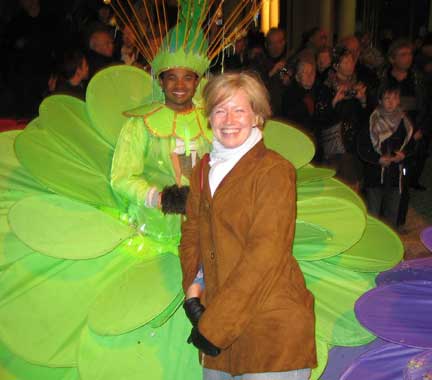
Stephanie Sommers catches the spirit, the spectacle, the excitement, and the humor of the king of French Carnival celebrations in Nice and its pucker-lipped little sister, the Lemon Festival at Menton, in a report of the Riviera’s most important winter festivals. This article gathers together highlights from blog she maintained on France Revisited during the 3-week festival period in 2009. The theme of these two festivals change from year to year but the spirit remains the same.
Before I moved to Nice I had been warned by friends in nearby Provence that this was a city of little old ladies and small dogs and that I should always look down at the pavement while walking in order to avoid the ubiquitous “ca-ca.” Their comments were perhaps inspired by the Provence-Riviera rivalry, but even in Nice I’d been told that the locals easily distinguish the tourists from the true Niçois by the fact that the former look up as they walk while the latter look down.
Nice is a big city with much going on, but those little old ladies—usually widows, I imagine due to their lack of male accompaniment—are as much a part of the city as the famous Promenade des Anglais that follows the curve of the bay. It’s not unusual to see their tan, wrinkly, svelte bodies lying around the beaches below the Promenade in groups of two or three.
I arrived in Nice just after the New Year. This wasn’t my first time in the city of widows, but I had only ever spent the odd weekend here. I chose the Cote d’Azur for the mild winter weather and Nice in particular for its language schools—it was time to master the language of Molière once and for all. As a bonus, I arrived just in time to witness one of the most famous winter festivals in Europe, Nice’s celebration of Carnival.
Carnival (Carnaval in French) is the period of festivities that precedes Lent—not that many people in French now pay attention to that religiosity. Basically, Carnival is Mardi Gras. Though Mardi Gras is technically Fat Tuesday, the day that precedes Ash Wednesday, it’s non-religious connotation (i.e. party time) has now led to it referring to the full period of festivities. Call it what you like, it’s party time!

Pre-Carnival buzz
Nice’s Carnival began on Friday evening, Feb. 13, but all that week there had been a buzz in the air. Nice is one of the larger cities on the Cote d’Azur so there’s activity in the streets all year, but beginning early in the week I noticed the arrival of an increasing number of people looking up—tourists no doubt. Despite the cold weather, the widows were out in force, bronzing themselves in preparation for the upcoming festivities.
The fabulous Promenade des Anglais—think the Champs Elysées of Paris but along the sea—is never really empty unless it’s raining, but it was getting increasingly busy. Bleachers had been in place for a few weeks already, and on Monday a massive TV screen was installed in historic Place Massena on which the various parades would be shown. The Nice Tourist Office was the first to decorate, putting a giant colorful lizard head up on the roof.
Nice’s Carnival, France’s largest, has been around for 125 years. Another major Carnival takes place in Dunkerque in northern France. Nice’s Carnival lasts for two weeks. There are festivities every day, punctuated by major events described here: the opening ceremony, the Flower Parades on Saturdays and Wednesdays, the night parades on Tuesdays and Saturdays and then the grand finale on the last Sunday.
This year’s theme was “King of Masquerades” whose inauguration was staged in a parade with 20 monumental floats, accompanied by over 200 big ‘heads’ much like the above-mentioned lizard.
Arrival of the King
The King arrived on Friday evening. By then it had become apparent to me that a lot of Niçois have never actually attended the Carnival because when I asked various locals what happens on the King’s arrival I never got a clear answer. They all seem to know the history: The King’s arrival commences the Carnival, and at the end of Carnival two weeks later is taken out to the sea and burned so that he can rise from the ashes the following year. But everyone was vague on the details.
What actually happens, I discovered at the opening ceremony, is this: There is a huge party staged in Place Massena with two enormous floats—the King and the Queen—that come from the direction of the large shopping street, Avenue Jean Medécin. The square is packed with revelers; confetti and Silly String are thrown about in huge quantities. Everyone is in a festive mood and dances in the middle of the square to the pop music blaring from loudspeakers.
Quite a few of the revelers were masked.
I asked one of them why and they said that this year the theme, The King of Masquerades, was an invitation to hide your identity and become someone else. This made it impossible to resist dancing and frolicking in the streets with perfect strangers. My friends and I made the most of it. Then suddenly we all realized that the King and Queen were bearing down on us, and we were in a panic as we all tried to make way for the giant floats to pass. As they passed by, you could see that there were masked people in costume inside the floats, waving and throwing confetti and spraying the crowds with Silly String. Revelers also sprayed each other. At first I wondered where all the aerosol string was coming from but after the parade I saw a few street vendors still hawking the stuff.
Trailing after the floats were various semi-organized groups in costumes, including a gaggle of children and some acrobats who danced in the streets. The whole experience reminded me of an exotic New Years Eve in Times Square as for a few hours strangers from around the world danced, laughed, and sprayed each other with Silly String. It was fantastic.
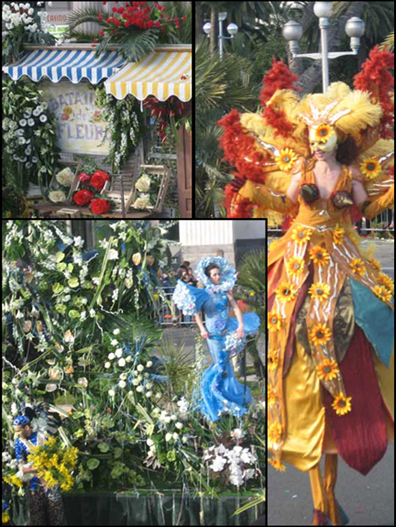
La Bataille des Fleurs – Battle of the Flowers a.k.a the Flower Parade
Honestly, someone should have warned me that the Bataille des Fleurs, the Battle of the Flowers, was not a contest between the flower floats in a parade but rather an actual “battle” to catch the flowers being thrown at the spectators throughout the parade.
The Bataille took place Saturday afternoon on the Promenade des Anglais. I was seated in the bleachers thinking that I had lucked out for picture-taking because seated around me were hundreds of gentle, sedate senior citizens who would never jump up in front of my camera. They were mostly couples, arms linked rather romantically (occasionally you saw one lone man with a few ladies seated around him; I’m guessing these lucky men were favorites of the widow crowd). “Aw, how cute” I thought, wishing I had someone special with me. As it was most of my friends had refused to pay the hefty 25 euro fee to sit in the stands and had opted to stand in the crowds on the other side of the street. And my one friend who had been willing had lost her ticket. So I was friendless in the stands.
The parade started with a bang when loud Brazilian music accompanied by an even louder announcer scorched our ears. I noticed a few of the seniors dialing down their hearing aids.
The first dancers to arrive were Brazilians scantily dressed like flowers. I had to laugh at the men in the bleachers trying hard not to look too much and the women acting scandalized when they caught their men ogling the dancers. One particularly Brazilian-shaped (read: nicely formed) dancer was sans flower and very nearly naked, shaking her bootie on uber-high heels. How could you help but stare!
Then the first flower-drenched float arrived. It moved slowly. I noticed there was someone just walking alongside the float with a cartful of flowers. The walker then started throwing flowers into the stands. This caused a roar from the crowd, and suddenly everyone was lunging forward trying to catch flowers. Fights erupted between the men who, I now realized, were supposed to try to catch the flowers in order to give them to their significant others. It was utter chaos. The formerly placid old men surrounding me who didn’t look like they could move unless assisted were now jumping up like grasshoppers, sometimes knocking over their loved ones in the process. Several times a few aggressive younger men very nearly came to fisticuffs. Their women gave each other the evil eye all in order to catch a flower or two.
This process went on throughout the parade. It was evident that this was a time-worn tradition as the women knew how to duck and weave whenever the flowers were thrown. A few were unlucky and knocked off their chairs but they just got themselves back up—in a very dignified manner, I might add. I myself was nearly knocked over a few times, but I managed to catch a few flowers, although the old ladies, seeing that I was manless, just sniffed and turned their backs on me.
The parade was fantastic—it’s hard to describe all of the various floats and costumes that passed by in the two-plus hours—and it was a photographer’s delight, but I think the real event was the battle. As the parade was coming around a second time the flower-tossers were now pulling flowers from the floats themselves and throwing them into the crowds. The competition got even more fierce. Slightly shaken, I decided to scurry out of there lest some loved-up senior decide to arm wrestle me for my armful of flowers.
Corso Illuminé
The Corso Illuminé is the night parade that circles two times around Place Massena on Tuesday and Saturday nights. The two corsos, or corsi, I attended were spectacular. There were enormous harlequins and huge floating caricatures of what would have entertained royalty back in the day, a rather fierce dragon (my personal favorite), and groups from various countries who entertained us in between the grotesque processions with acrobatic dances, drum-playing, or baton-twirling. They slowly passed by as the crowd heaved to and fro, filling in the spaces between each float.
It was interesting to see the spectators get up close and personal with the floats, and armed with aerosol string cans (boums, in French) and confetti, they would spray the heck out of the floats, the groups, and each other until everybody and everything was covered in string and confetti.
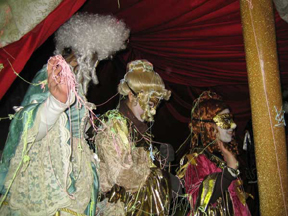
Those of us who chose not to buy boums and confetti were frequently targeted with stealth attacks from behind as if the boumeurs (think bombers) were saying, “Hey, you there, blocking my view and my chance to spray a float, this one’s for you!”
I was told by my French teacher Jean-Philippe (probably referring to pre-aerosol string days) that years ago they threw little plastic balls a bit bigger than bb pellets and which weighed a bit more than bb pellets (I’m guessing) as there were always a few eyes put out and, according to my informer, a couple of near deaths. As Carnival became increasingly popular with tourists from other countries they finally banned the pellets and switched to paper confetti and the infamous boums.
After a few days of partying and picking string off my clothes I stayed home one evening to do research into the origins of Nice’s Carnival. Nice’s Carnival is mentioned various times in the journals of royal patrons during the Middle Ages. It appears to have been particularly popular with dukes from France and Italy and that in 1889 the Prince of Wales (future Edward VII) came to light the procession stake to commence Carnival.
My favorite float, the dragon, is called a “babau” and first appeared as a float in 1882 to honor the tradition of grotesque mythology that is prevalent in most Carnival histories. Here is where mythology and Catholicism meld. Winter Carnivals are now said to be a celebration of the advent of Lent, which is why Mardi Gras (literally “Fat Tuesday”) commemorates the end of the Carnival period and incorporates a huge feast so that Catholics can get ready for eating meagerly (specifically no meat) for Lent, the 40 days leading up to Easter. Nowadays my Catholic friends usually resolve to give something up like sugar in their coffee or white wine. (Notice they don’t say all wines.) According to tradition, then, all manner of wild behavior and voluntary madness is allowed during this Carnival period as you would pay penance during Lent. Perhaps this explains the folly of Silly String.
Street food in Nice: the socca party
I could write at length about how, after a week of cool weather, we finally had a beautiful sunny day, and how my friends and I gathered together on the Promenade des Anglais along with a few thousand tourists to watch the parades most days. But what I really want to do is write a love letter about a Niçois street food called the socca.

Socca is a thin, moist-on-the-inside, crispy-on-the-outside pancake made of chickpea flour, olive oil and salt and baked in huge pizza pans in wood burning ovens. It is delicious, especially if, like me, you have been living it up all weekend and are moving just a bit slower than usual on a Sunday afternoon. It is served on little paper plates. You just add pepper.
I’m not the only one who loves socca. In the Albert 1er gardens next to Place Massena, the Carnival held a socca party and everyone queued for over half an hour just to get a plate of socca. The line was so long that kids waiting with their parents were bored silly and as a result used up most of their aerosol string cans on all of us waiting in line. Other targets included the wandering bands of Spanish singers, a few clowns and the occasional palm tree. On most Sundays the queues are just as long at the socca restaurants in old town Nice.
The socca in Vieux (Old) Nice is served alongside other local specialties such as pissaladière (caramelized onion pizza sometimes with bits of anchovy and black olives), pan bagnat (little buns brushed with olive oil, then filled with green pepper slices, black olives, onion slices, anchovies, tomato slices and hard-boiled egg slices — all drizzled with vinaigrette), niçois farcis (vegetables like zucchini, peppers and onions cut into bite size pieces and topped or stuffed with delicious fillings made of meat or fish or other vegetables), and beignets (shrimp or meat fillings dunked in a thick batter and deep fried).
All of these are finger foods—although your fingers tend to get very greasy—and families, couples, and friends gather together at brunch time to sit at the picnic tables outside, eat some Nice street food, and wash it all down with a glass of rosé. Yum!
While Nice parties through Carnival, Menton hosts its Lemon Festival
While Nice was holding its Carnival the pretty Riviera town of Menton, sitting between the Italian border and Monaco, holds its Lemon Festival, la Fête du Citron.
I’d visited the Riviera a number of times before moving here but for some reason I’d never thought to go east of Monaco. Now I think it’s a shame that it took me so long since Menton is indeed worthy of at least a daytrip.
The Lemon Festival is also basically Carnival/Mardi Gras/party time while being directly linked to that fact that the climate in Menton is ideal for growing lemon trees and other citrus. Known as the City of Lemons, Menton distinguishes itself from the rest of the French Riviera by having a subtropical climate that, in addition to its attractiveness to lemon trees, has earned it a special place in the heart botanists and garden-lovers.
The town has won many awards for being the top “floral” town in France. Botanists have been coming here since the 1800s to plant rare species of flowers and plants because they can thrive in this climate. About 115 acres (46 hectares) of park space surround the town, with contemporary gardens created in the very heart of the city. During the Lemon Festival the garden at the center of the town becomes the setting for the jardins illuminés or illuminated gardens/gardens of light.
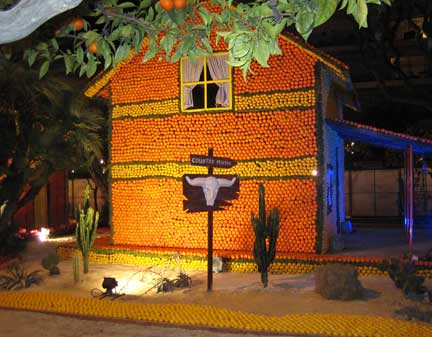
During an afternoon reconnaissance mission from Nice I was struck by the fact that although this is on the coast and therefore should be loaded with tourists and little old ladies with tiny dogs, it isn’t, so you can walk through the pedestrian area without having to watch your step. Menton (pop. 29,000) has its charms but isn’t quaint per se, though it has an elegant feel that is sometimes lacking in Nice. It is one of the few towns in France where the population is actually getting younger, and the downtown area appears to be particularly clean.
In preparing this article I didn’t actively set out to test restaurants but I can nevertheless report that of I’ve enjoyed the several meals I’ve had here. In Nice, on the other hand, which has some great food possibilities, haphazard selection can lead to some bad and overpriced meals and hit-or-miss service.
The Lemon Festival, first held in 1934, runs about three weeks. The theme for 2009 was “Menton celebrates the Music of the World.” And indeed the night we went everything from African tribal to American country music was being played in different venues in the gardens. My friends and I were delighted; a town that actually encourages music and dancing is a town that we can love.
Since my army of friends marches on its stomach, no sooner had we arrived then someone suggested we find a restaurant. We stopped at La Tagliatelle, an Italian restaurant across the street from the beach and promenade. It was absolutely fantastic and came complete with two huge Italian waiters. They’re brothers and they look like Mama breast-fed them pasta from the day they were born. Jolly as they were, it was the clientele who spoke volumes: La Tagliatelle must be a badly kept secret amongst the Italians as I heard no French in the restaurant, only Italian. (Remember, Italy is only a few miles away.) We each had a different pasta and left nothing behind. The lemon tart, tarte au citron, was fabulous, with no complaints about Le Colonel, a lemon sorbet topped with lemon vodka topped with a tiny bit of whipped cream.
After the meal we attacked the night garden event, and within five minutes a big stuffed clown thing was flirting and dancing with me… and trying to touch my bum while we were dancing.
Swiftly moving on, we came upon a quite good mariachi band which had us shaking our booties once more. Through the evening we frolicked amongst several other musical venues: country, disco, tango, rock-‘n-roll, etc. The venues themselves were each shaped a bit differently—there was a house, a chateau, a boat, a car, even a ‘moulin rouge’—all composed of thousands of lemons and oranges! Officially, the Lemon Festival uses about 145 tons of citrus fruit.
Open for dégustation throughout were small stands selling some of the best limoncello (sweet digestive liqueur made of lemons) I have ever tasted.
At the far end of the gardens Grand Marnier, makers of the famous orange liqueur, had set up a creperie that was serving warm Grand Marnier and coffee. By this time it was late and we were tired, so we all had a glass of Grand Marnier, tipped it in admiration to the magical music village, and caught the last train back to Nice.
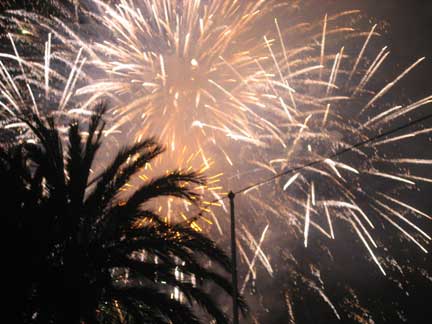
We returned to Menton for a second evening of lemon festivities for the parade and fireworks. The parade itself was a little disappointing since it contained few surprises as it mainly consisted of the various village settings made of oranges and lemons that we had already seen. Or maybe the parade was a bit disappointing because we had been going to the far more spectacular night parades in Nice where the crowds were enormous and more international and showed more enthusiasm in the streets. Nice’s Carnival attracted more than a million visitors in 2009 whereas Menton’s Lemon Festival drew about 230,000. The crowds in Menton seemed mainly to be French, and the French, in my experience, don’t publicly dance or express themselves at such events like the English, Americans, Germans, Swiss, Dutch, etc.
Nevertheless, Menton is quite elegant and easily manageable for the tourist who wants a French seaside town flavor without all of the excessive tourist trappings, and that extends to its Lemon Festival as well. The benefit of attending Menton’s parade compared with Nice’s is that when Menton’s slows down you can walk right in between the various acts to take pictures. Another advantage is that there is far less Silly String in Menton.
The fireworks were rather special, particularly as they illuminated the sea—and who doesn’t love fireworks?! The whole event, while sedate compared to the Nice Carnival, was nicely presented.
Afterwards we all headed for the train station, satisfied with the food and festivities… but soon to be unsatisfied with the return home to Nice. As befitting a typically subdued town, there are no buses leaving Menton after 8 pm, so everyone without a car must take a train to get home if they don’t live there. The majority of people seemed to be headed east, as we were, in the direction of Nice and Cannes. Add the fact that the SNCF, the French rail service, had cancelled the two trains before the last one heading east, which was also delayed for over an hour, and you have a recipe for chaos.
The fireworks had ended around 10 pm but at nearly midnight there were still hundreds of people waiting for a train. The police were already there in advance, waiting to quell any possible riots and to keep people from being pushed off the platforms, but it would have seemed more reasonable to send in train reinforcements rather than police reinforcements.
The train finally arrived, and for about 10 minutes we couldn’t breathe, let alone move as the crowds—a not very young crowd at that—pushed forward to the doors. It was a nightmare that really only ended when we arrived in Nice. In short, check the bus and train schedules if you aren’t staying at a hotel in Menton.
The burning of the King and the end of Carnival
Back safely in Nice, I again turned my attention to the Carnival, which came to an end on a Sunday night. The burning of the king in the sea marks the end of the festivities and the start of Lent. Legend has it that by burning the King he will then rise again next year from the ashes to reign once again during the Carnival.
It was one of the more frenzied nights of the Carnival period. By 9 pm tens of thousands of revelers were gathered in Place Massena to escort the King to the sea. With music blasting over loudspeakers everyone danced in the streets, working themselves up for the ritual burning. The Silly String and confetti were flying everywhere; I had hoped that maybe they would have sold out of the stuff by now but it was actually even worse. I saw one little girl of maybe 5 or 6 being completely covered by Silly String by her parents and elder siblings, after which they threw confetti on her. My friends and I wondered whether that might constitute child abuse, but the child seemed to be enjoying it.
When the King started to move, the crowd roared bloodthirstily and followed the King down to the sea. My friends and I raced ahead to the Promenade des Anglais to take pictures of the procession. Then, as the King rounded the corner, we realized that the crowds at the beach were so immense we would never be able to see the King out at sea.
This is where I admit to having a slight advantage over typical visitors since I found the most official-looking person in the crowds, flashed my press badge, and asked where the press area was. We soon found ourselves in a private viewing area on the Promenade des Anglais, directly in front of the boats out at sea that were set up for the burning and the fireworks afterwards.
But the King was already out there! How was that possible when we had just left him at the corner? I soon discovered that they don’t actually burn the massive grotesque King we had all seen in the parades; instead an effigy made of paper maché is burned. Considering that the real King is made mostly of hard plastic this actually makes sense.
As we waited, the crowds behind us grew more bloodthirsty. Their chant of “Brule!” (Burn!) got more and more intense. Suddenly the announcement came that it was about to happen, and there was a brief pause in the yelling and screaming as they lit the King on fire.
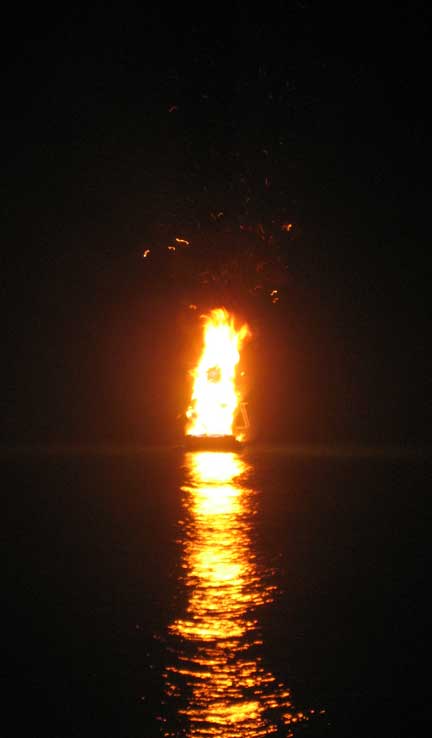
As the fire took, the revelers found their voices again and they roared through the 5-6 minutes it took to burn the effigy. As the fire died down, so did the voices, save for one child’s voice who yelled out one last comment: “Au revoir, Sarkozy!” We all laughed.
Immediately after the burning of the King the fireworks began, and it was evident where a good portion of the city’s 6-million-euro Carnival budget went. They were spectacular. Four boats out at sea shot off fireworks in tune to approximately ten different songs as we watched from our advantageous press-passed position. The fireworks seemed endless.
Then it was over.
As my friends and I waded our way through the Silly String-and-confetti-filled streets we noticed that the formerly frenzied crowd had lost its energy and vitality. Everyone shuffled back to their home or hotel. The party was over, and we all knew it was time to take off our Carnival masks and return to our real lives.
Tourist Offices and Festival Information
Nice: Nice’s official Carnival website.
Menton: Menton’s official Lemon Festival website.


